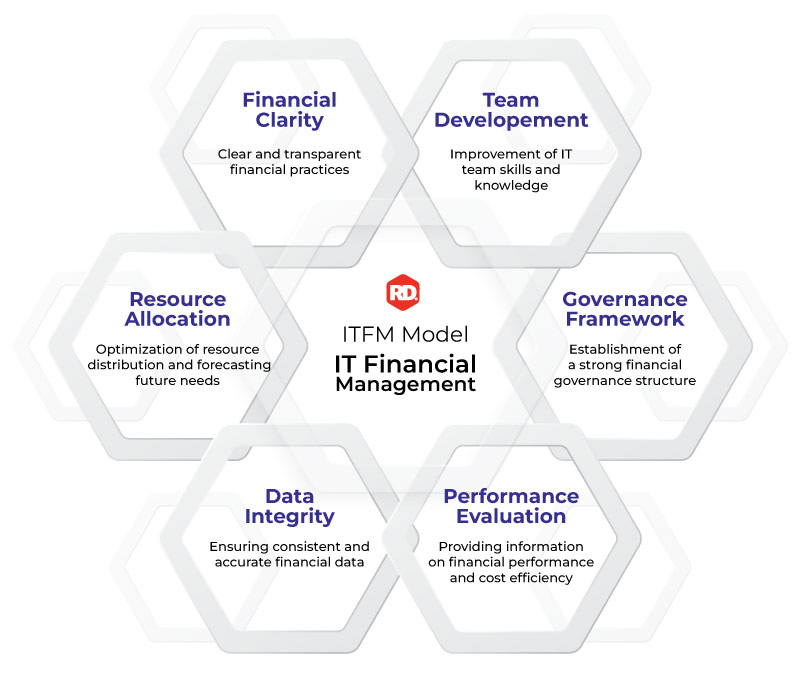Keys to Strengthening IT Budgets and Facilitating CIO-CFO Interactions
Reading: 2 mins.
The process of creating an IT budget can seem challenging. CIOs must justify IT spending and align their strategies with organizational objectives. Meanwhile, CFOs seek clarity, transparency, and return on investment. How can CIOs address this challenge?
In this article, we break down the keys to creating an effective IT budget, explore how the ITFM (IT Financial Management) methodology facilitates communication with CFOs, and how HOLO can automate the process, simplifying management.
1. Common Challenges in Creating an IT Budget
Before implementing the ITFM methodology, CIOs must proactively identify and manage challenges that may arise in formulating an IT budget:
Unclear Business Objectives: IT budgets must align with strategic goals to ensure effective fund allocation. Disconnects between executive expectations and technological planning can result in investments that do not support corporate growth. For example, investing in new technological infrastructure without a clear growth strategy can lead to expenses exceeding the projected benefits.
Difficulty Demonstrating IT Value: CIOs need to demonstrate IT value beyond operational costs. CFOs require quantifiable justification to approve technology investments. For instance, implementing a new data management platform must show how it will generate a measurable return on investment by improving operational efficiency or unlocking new revenue opportunities.
Lack of Financial Priorities Understanding: A lack of understanding of financial indicators, cost containment, and strategic alignment can create issues for CIOs. Projects that do not clearly demonstrate how they will reduce operating costs or improve return on investment will face significant obstacles to approval.
Complexity in Cost Categorization: Fund allocation can be complicated if CapEx (capital expenditures) and OpEx (operating expenses) are not clearly distinguished. For example, software licenses might be mistakenly classified as capital expenses, despite having an annual subscription fee, leading to inaccurate budget planning.
Ineffective Communication: Clear communication between IT and finance teams is essential to ensure understanding of investment needs. Otherwise, a lack of clarity can lead to ineffective budgeting processes. For example, if the need for cybersecurity investments is not clearly articulated, it may be seen as an unnecessary expense rather than a strategic investment for business continuity.
By understanding these challenges and addressing them from a financial perspective, CIOs will be better positioned to implement the ITFM methodology and create an IT budget that supports the organization’s strategic priorities.
2. ITFM Methodology: A Structured Guide to Creating IT Budgets
The IT Financial Management (ITFM) methodology offers a structured approach that helps CIOs create transparent IT budgets aligned with organizational financial priorities.
Key points of the methodology include:
Understanding Perspectives: ITFM emphasizes understanding the different stakeholders’ perspectives, from CFOs to business unit leaders, to better reflect their needs in the IT budget. This facilitates the use of related keywords like “strategic objectives,” “business alignment,” and “efficient IT budgets.”
Breaking Down CapEx and OpEx: Clearly separating capital expenditures (CapEx) from operating expenses (OpEx) allows CFOs to see how each expense impacts the business in the short and long term. It also helps CIOs identify opportunities to reduce operating expenses and maximize capital expenditure efficiency, enabling more effective resource use.
Streamlining Projects and Expenses: ITFM promotes streamlining all IT projects to eliminate redundancies, prioritizing initiatives with the most significant impact on strategic objectives. This optimizes resource use and improves financial management.
Alternative Scenarios: Considering multiple scenarios helps prepare responses to different economic situations. This can include growth, stability, and austerity plans. Thus, CIOs can anticipate possible economic changes and adjust the IT budget accordingly.
Clear Justification: The methodology highlights the importance of providing clear justification for each expense. CIOs must link each investment to a tangible business benefit, such as increased operational efficiency or new revenue generation. This enhances transparency and communication between IT and finance teams.
Understanding the ITFM model in detail and its maturity level within the organization is crucial.

Contact us to implement the ITFM Model
3. Improving Communication with CFOs
For IT budgets to be effectively approved, CIOs must improve their communication with CFOs by adopting the financial language used by finance teams. Here are some strategies:
Speak in ROI Terms: CFOs respond better to arguments that link IT spending to return on investment (ROI). CIOs should present a clear analysis demonstrating how each investment will generate additional revenue or reduce operating costs.
Clarity and Transparency: Provide a clear view of the total cost of ownership (TCO) and the impact each investment will have on the cost structure in the long term. The figures and data presented should be easily understandable for CFOs.
Align IT with Business Strategy: CFOs want to see that IT spending is aligned with business objectives to minimize risks. CIOs must ensure that each IT project contributes to the overall business strategy.
Be Flexible: Having a flexible budget that allows adjustments according to economic changes or priorities is essential for CFOs. This means CIOs should consider different scenarios and be prepared to adjust the budget accordingly.
4. Automating the Budget with the HOLO Platform
Managing an IT budget manually can be challenging, as data complexity can lead to errors and misunderstandings. The HOLO platform can simplify this process by automating it, thanks to its configuration based on the ITFM methodology.
Automated Breakdown: HOLO automatically classifies expenses between CapEx and OpEx, helping CIOs identify areas for improvement and CFOs understand resource allocation. This functionality optimizes expense classification and facilitates report generation.
Alternative Scenarios: With the ability to create alternative scenarios, HOLO allows CIOs to show how different spending levels impact the business. This functionality enhances forecasting and strategic planning.
Detailed Reports: Generating custom reports facilitates communication with CFOs, showing metrics such as TCO, ROI, and long-term cost projections. Additionally, HOLO provides visual reports that allow identifying trends and opportunities.
Strategic Alignment: HOLO helps align the IT budget with company objectives by linking each expense to strategic projects. This improves collaboration between IT and finance teams and facilitates informed decision-making.
Lifecycle Management: HOLO’s financial module provides complete visibility into the expense lifecycle, controlling cash flows, budget deviations, and optimizing items for more stable growth. Tracking each lifecycle stage allows CIOs and CFOs to adjust the budget as needed.
Vendor Management: HOLO also offers a module for managing the supplier lifecycle, including monitoring deliverables, integrating service levels (SLA), and generating a score for each supplier. Intelligent supplier management ensures contract efficiency and reduces the risk of deviations.
5. Tips for Implementing a Transparent IT Budget
In addition to using a structured methodology like ITFM, CIOs can follow these tips to improve the quality and transparency of their budgets:
Involve All Stakeholders: Collaborate with all relevant teams, such as finance, sales, and marketing, to identify needs and align the budget with priorities.
Analyze Historical Data: Review previous budgets to identify patterns, improvement areas, and potential risk points. This will help improve forecast accuracy.
Use Key Performance Indicators (KPIs): Define and monitor specific KPIs to measure the performance of each investment. This will allow adjustments as needed.
Financial Management Training: Provide training to IT teams on key financial concepts to improve communication with CFOs.
Detailed Documentation: Maintain detailed documentation of the budgeting process to ensure transparency and compliance with internal policies.
In Conclusion
Creating a transparent and effective IT budget is crucial for CIOs to gain CFO approval.
By using the ITFM methodology, CIOs can design a budget that demonstrates IT value, speaks the language of CFOs, and reflects the organization’s strategic priorities
Suscribe to our Blog
You’ll receive updated information about vendor lifecycle management and automation.
Any information about the protection of your data, please read our Privacy Policy
Suscribe to our Blog
You’ll receive updated information about vendor lifecycle management and automation.
Any information about the protection of your data, please read our Privacy Policy.






